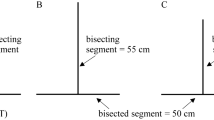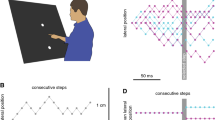Abstract
Goal-directed movements are generally slightly curved. The origin of this curvature has been related to a misjudgment of direction for movements towards visual targets. As it is known that there are large errors in haptic perception of direction, errors in the initial movement direction in movements towards haptic targets may also be related to errors in haptic perception of direction. To test whether this is indeed the case, we compared errors in the initial movement direction of goal directed movements towards haptically defined targets in a mid sagittal plane with the errors in setting a pointer towards the same targets. We found a good correlation between misjudgment in direction and errors in initial movement direction. We conclude that the curvature of movements towards haptic targets is also due to a misjudgment of direction.
Access this chapter
Tax calculation will be finalised at checkout
Purchases are for personal use only
Preview
Unable to display preview. Download preview PDF.
Similar content being viewed by others
References
Boessenkool, J.J., Nijhof, E.J., Erkelens, C.J.: A comparison of curvatures of left and right hand movements in a simple pointing task. Experimental Brain Research 120(3), 369–376 (1998)
Flanagan, J.R., Rao, A.K.: Trajectory adaptation to a nonlinear visuomotor transformation: evidence of motion planning in visually perceived space. J. Neurophysiol. 74(5), 2174–2178 (1995)
Wolpert, D.M., Ghahramani, Z., Jordan, M.I.: Perceptual distortion contributes to the curvature of human reaching movements. Exp. Brain. Res. 98(1), 153–156 (1994)
Wolpert, D.M., Ghahramani, Z., Jordan, M.I.: Are Arm Trajectories Planned in Kinematic or Dynamic Coordinates - an Adaptation Study. Experimental Brain Research 103(3), 460–470 (1995)
de Graaf, J.B., Sittig, A.C., Denier van der Gon, J.J.: Misdirections in slow goal-directed arm movements and pointer-setting tasks. Exp. Brain Res. 84(2), 434–438 (1991)
de Graaf, J.B., Sittig, A.C., Denier van der Gon, J.J.: Misdirections in slow, goal-directed arm movements are not primarily visually based. Exp. Brain Res. 99(3), 464–472 (1994)
Smeets, J.B.J., Brenner, E.: Curved movement paths and the Hering illusion: Positions or directions? Vis. Cogn. 11(2-3), 255–274 (2004)
Kappers, A.M.L., Koenderink, J.J.: Haptic perception of spatial relations. Perception 28(6), 781–795 (1999)
Kappers, A.M.L.: Haptic perception of parallelity in the midsagittal plane. Acta Psychol. 109(1), 25–40 (2002)
Smeets, J.B., van den Dobbelsteen, J.J., de Grave, D.D., van Beers, R.J., Brenner, E.: Sensory integration does not lead to sensory calibration. Proc. Natl. Acad. Sci. USA 103(49), 18781–18786 (2006)
Miall, R.C., Haggard, P.N.: The curvature of human arm movements in the absence of visual experience. Exp. Brain Res. 103(3), 421–428 (1995)
Author information
Authors and Affiliations
Editor information
Editors and Affiliations
Rights and permissions
Copyright information
© 2012 Springer-Verlag Berlin Heidelberg
About this paper
Cite this paper
van der Graaff, M.C.W., Brenner, E., Smeets, J.B.J. (2012). Is the Curvature in Hand Movements to Haptic Targets in the Mid Sagittal Plane Caused by a Misjudgment in Direction?. In: Isokoski, P., Springare, J. (eds) Haptics: Perception, Devices, Mobility, and Communication. EuroHaptics 2012. Lecture Notes in Computer Science, vol 7283. Springer, Berlin, Heidelberg. https://doi.org/10.1007/978-3-642-31404-9_6
Download citation
DOI: https://doi.org/10.1007/978-3-642-31404-9_6
Publisher Name: Springer, Berlin, Heidelberg
Print ISBN: 978-3-642-31403-2
Online ISBN: 978-3-642-31404-9
eBook Packages: Computer ScienceComputer Science (R0)




